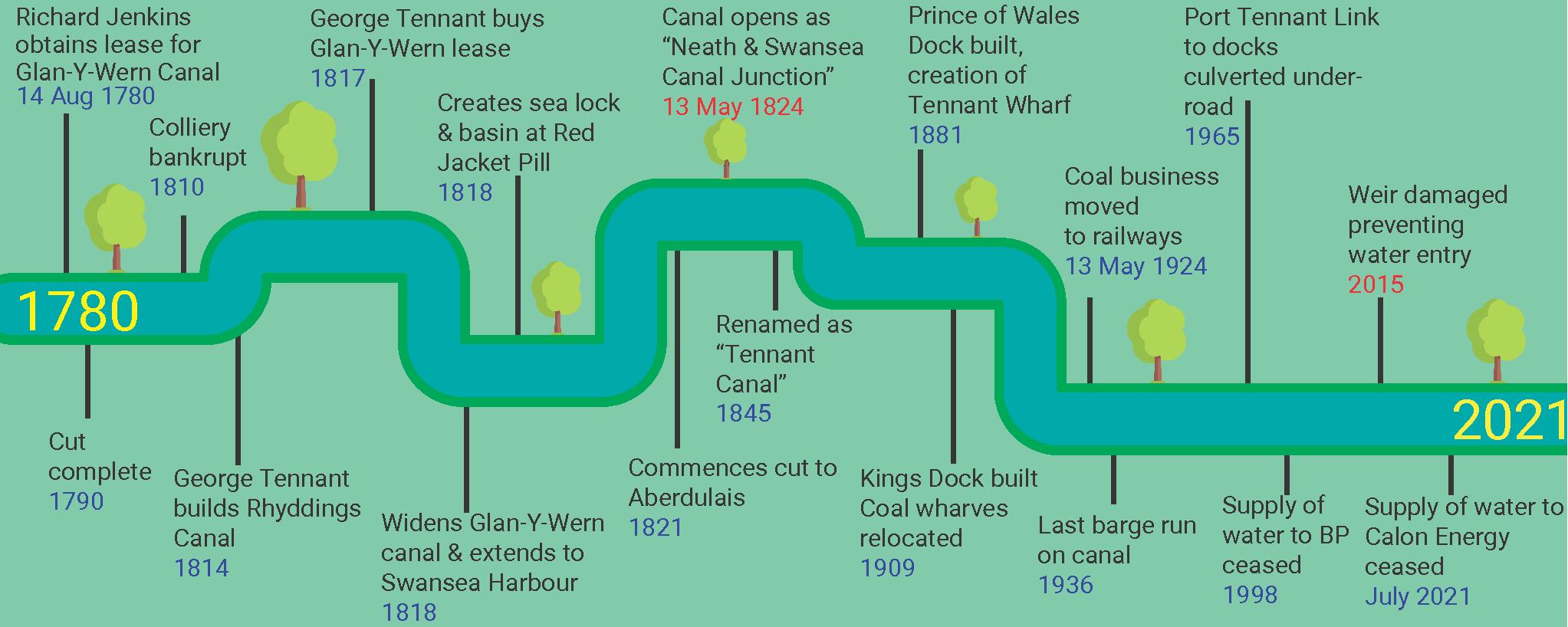
History of the Tennant Canal
George Tennant, a Solicitor from Lancashire, while in the South Wales area on business for others, could see opportunities to make money from the Coal trade, and while of no specific engineering background – he was certainly keen on canals.
To understand the history of the Tennant Canal it’s necessary to consider its predecessors:
GLAN-Y-WERN CANAL:
Richard Jenkins operated a colliery at Glan-y-Wern, which is at the North West corner of Crymlyn Bog, about 1km due East of Cefn Hengoed School. (see Map 1)
The colliery was registered as the Glanywern & Tyrisaf collieries Ltd. (sic)
To get his produce - Culm (Anthracite coal) to market he had envisaged a Cutting from his colliery, down the side of the Crymlyn bog and then due East to ‘Trownman’s hole’ . The land was owned by Lord Vernon and Jenkins applied to him for a lease to undertake this work ….. the lease was granted on August 14, 1788 … unfortunately Jenkins died the same day. His partner Edward Elton took over the colliery and his plan, with a Canal being created by 1790,
It is worth understanding that at this time there were no docks at Swansea, just a tidal estuary, and most coal was exported from the coal wharves at Giants Grave, Briton Ferry.
The Canal terminated at Trowman’s Hole …. which was to be later known as Red Jacket Pill, there was no direct connection to the river, and barges were unloaded and then ships would come across the river Neath on flood tide to be loaded up at Red Jacket Pill.
This business continued until 1810 at which time the colliery went bankrupt, and Edward Elton died, the landowner then placing a distraint order on the coal wharf at Red Jacket Pill and on the barges thus preventing any business and the canal fell into disuse.
The East-West section of the Canal became incorporated into the Tennant canal, in later years it was extended with branches to Tir Jon and to a large holding basin, the Canal still exists today up through the bog, but has had little maintenance since 1910 when Canal business ceased.
It does provide a useful source of fresh clean water into the canal, helping to drain the Crymlyn bog which is now an important Site of Special Scientific Interest (SSSI), the largest lowland wetlands in the UK, and the home to many rare species of Flora & Fauna.
Later another cut was created, with a branch running parallel to the Glan-y-Wern running to the Tir-isaf Colliery (Port Tennant).
Red Jacket Pill
Red Jacket Pill is a natural stream emanating from Crymlyn bog and entering the River Neath. The Red Jacket Pill in 1818 was turned into a short 2km long canal built by William Kirkhouse.
Its primary purpose was conveying copper ore from across the River Neath at Briton Ferry to the 'Briton Ferry Copper Works' and on the opposite bank of the river to 'Red Jacket Copper Works'.
Jacket PIll Lock is a barge lock connecting a basin at the end of the canal and allowing locking to the Neath River and reaching Swansea by means of the Glan-y-Wern canal constructed in the 1780s.
Constructed by William Kirkhouse, it could handle barges up to 61 Ton, the remains of this canal basin & lock are still evident. Nearby the main canal in 1824 was rerouted to go East on to Aberdulais, and this terminus dropped into disuse.
Rhyddings Canal
The Rhyddings Estate was an area of land around Bryncoch, owned as was much of the area by the Earl of Jersey.
In 1814 the Estate was purchased by George Tennant, who reopened the closed colliery – which was situated not far from where the Dyffryn Arms pub now stands.
It had been previously operated as a colliery from 1767, and there was a stream from pumping at the workings down to the Redding Farm (now Rhyddings Farm Yard)
This canal was constructed by the widening of the stream, and was originally known as the Redding Canal, he used rudimentary wooden containers to transport the coal to Redding Farm, where it was then moved by an Inclined tramway to the River Neath.
On its path it crossed the Ynysygerwn Estate without permission, a decision that would create a lot of issues in later years for George Tennant.
This initial foray into canal construction was the start of his future endeavours.
Tennant Canal
George Tennant’s plan was to take out a lease on the disused Glan-y-Wern canal, widen, deepen and extend it, to take barges of around 50’-60’ in length and with a capacity 30-35 tons
His plan was to build a river lock at Red Jacket Pill, so that boats could be floated in on a flood tide to allow loading with less reliance on tide times.
He also planned to extend the Glan-y-Wern Canal Westwards to join the River Tawe via a river-lock providing access to the tidal estuary of Swansea harbour.
This grand plan required backers, and while the landowners were positive about the proposition, none provided financial input, so he decided to go it alone. Creating a new ‘Tennant’ canal from Swansea harbour through to Red Jacket Pill, locked at either end .. he engaged an engineer – William Kirkhouse, and this ‘new’ 4 mile canal was completed in 1818. This allowed full barges to enter the lock at Red Jacket and proceed through to Swansea, Tennant assumed business would be good providing mine owners with access to Swansea harbour.
This was not to be, the business was low …
Under the Act of Parliament - ‘Neath Canal Act of 1798’ that allowed the Neath canal to be built, there was an obligation to build a sea-lock, without this … all coal had to be unloaded at Giants Grave, from the canal barges, and reloaded to ships to cross the River Neath.
This made the cost too high. Repeated efforts to get the lock built were unsuccessful, it is apparent that the owners of the Neath Coal Wharves were not sympathetic to an endeavor that would lose them export business.
During the multiple discussions & delay tactics, George Tennant came up with a solution that was to change things completely, plus no doubt give him the satisfaction of taking business from those that were obstructive.
His plan was instead of terminating at Red Jacket Pill, to turn left and route via Neath Abbey right through to Aberdulais, construct an aqueduct and lock to allow barges to connect directly to the Neath canal.
This would allow the mines at Glyn Neath and Aberpergwm direct access to Swansea for export, providing faster and cheaper routes to market.
Tennant commenced this work in 1821 again using his engineer William Kirkhouse. To maintain full control over the business and the significant proceeds he decides not to do this with an Act of Parliament (which allows for compulsory land purchase etc) but to undertake this as a purely private concern.
The first part of construction proceeded at pace, until they came to the land around Neath Abbey, geotechnical problems arose due to the existence of quick-sand, which meant the soil had no strength, and any banks would be unstable, and liable to collapse into the canal. Tennant took to the engineering solution of constructing an inverted arch of brickwork …. Encasing the canal for a length of 500m. The next problem arose at Cadoxton …. Here Tennant did not own the land and the route crossed land owned by Dillwyn family .. who were very intimately tied to the Coal business in Neath (and Giants Grave)
For over 2 years intense negotiation, positioning and arguments took place, with many caveats agreed on not providing cheaper transport, or cheaper tonnage levies, etc. compared to the Neath canal Company.
Finally, in 1824 the canal was finally complete with the opening of the Aberdulais Aqueduct, with access to the Aberdulais basin and thence the Neath Canal.
It’s important to realise that the canal from Swansea Harbour through to Aberdulais was 8.5 miles of lock-free waterway, it was immediately apparent that the Mine owners much preferred this faster route to Swansea and access to far better shipping services.
The canal grew several short branches to local industry:
- Neath Abbey Iron Works branch
- Dulais branch to the forge on the River Dulais
- Aberdulais Falls
- Neath River branch with a river lock to Crown Works
- Branch to Vale of Neath Brewery (Cadoxton),
- Neath branch with a river lock, opposite town quay
AQUEDUCT
This itself is an impressive engineering feat, a stone-built 10 arched aqueduct just over 100m long, lined with a cast-iron trough. In addition to the Aqueduct was a lock gate to allow barges to be lifted up from the Tennant Canal level to the Neath canal … some 14’ higher.
Just upstream of the Aqueduct is a low weir, that creates a pond upstream, this is used to provide a water supply into the Tennant canal from the end of the river Dulais. The operation of the locks provided significant quantities of water with each transit
This conglomeration of canals, lock, feeder channel & Aqueduct was originally named the Neath and Swansea Junction Canal, before being renamed The Tennant Canal.
DEMISE OF THE WORKING CANAL
The move to Kings dock coincided with the significant expansion of the railways and the transport of coal by train rather than barge. The switch happened quickly such that almost zero coal went by barge by 1910. There was other cargo …. Blue clay dug out from the marshes which would be conveyed to Cape Copper Works, or to the docks for any number of foundries & brick yards. Silica came down the Neath canal to be used by Brickworks to make fire bricks … much in demand locally due to its very high quality and the number of furnaces lining the river Tawe. Close to the Glan-y-Wern junction was ‘Pritchard Chemical Works’, and many barge loads of raw materials went to the works, and it was said the surface of the canal nearby was so polluted it looked like a sheet of brown linoleum. The last horse-drawn barge ran in 1936 and was a load of Blue Clay.
In 1956 from near the Vale of Neath Inn, Port Tennant the canal was drained, and in 1965 was culverted and a road laid over it, eventually becoming Fabian Way. The culvert still exists connected to the Eastern end of PoW dock. That meant there was no longer a navigable way from Swansea via the canal, and the end of an era.
LATER YEARS
With no cargo business, the canal looked destined to become silted up and lost to history … and in fact, at the Western end there is approximately 500m closed due to such silting, close to where the Carbon Black works was, now fully blocked. The ownership of the canal remains with the Coombe Tennant family, and for a number of years, they had revenue income by supplying water to Llandarcy Refinery until its closure in 1998. They also supplied water by pipe under the River Neath to Baglan Bay Chemical works, and in more recent times to Calon Energy Power Station.
With the very premature closure of the Power Station there is no longer any significant water supply business, and the owners have cancelled their Abstraction License, which puts the canal’s water supply at risk.
The Coombe Tennant family does wish the canal to remain in place as a natural environmental asset, for the benefit of the public and fully wishes to secure its future. This group is committed to working with Coombe Tennant, its agents, and all involved organisations to make this happen.
Save The Tennant Canal | Made for The Community*
*By local tech Steve Thomas who gave his time and skills for free to help save the canal.



